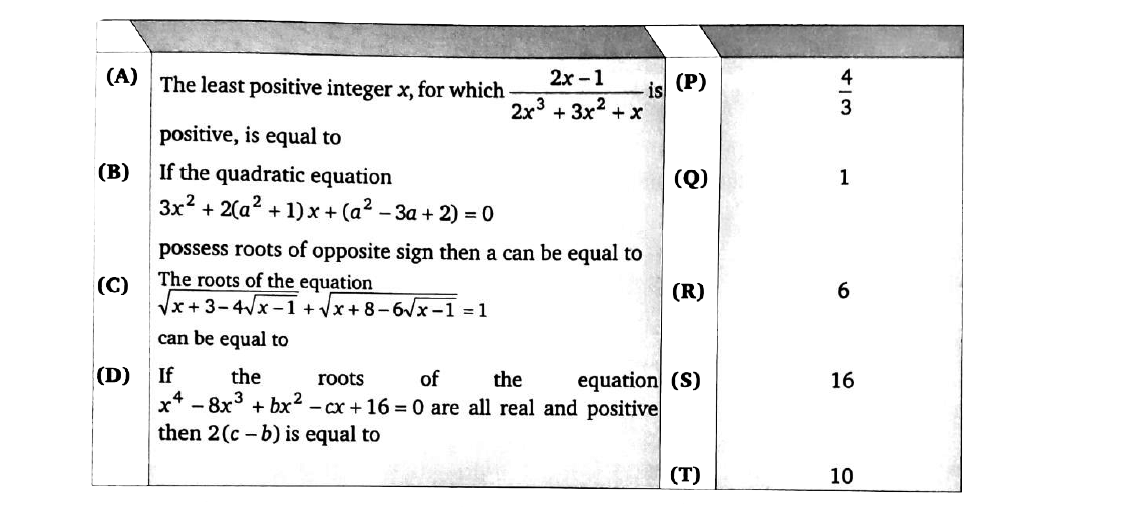Let the inequality sin2x+acosx+a2≥1+cosx is satisfied ∀x∈R, for a∈(−∞,k1]∪[k2,∞), then |k1|+|k2|=
The correct Answer is:3
Step by step video & image solution for Let the inequality sin ^(2) x+a cos x +a ^(2) ge1+ cos x is satisfied AA x in R, for a in (-oo,k_(1)] uu[ k_(2), oo), then |k_(1)|+ |k_(2)|= by Maths experts to help you in doubts & scoring excellent marks in Class 12 exams.
Updated on:21/07/2023Topper's Solved these Questions
- QUADRATIC EQUATIONS BOOK - VIKAS GUPTA (BLACK BOOK) ENGLISHCHAPTER - QUADRATIC EQUATIONS EXERCISE - EXERCISE (MATCHING TYPE PROBLEMS)
4 Videos
- PROBABILITY BOOK - VIKAS GUPTA (BLACK BOOK) ENGLISHCHAPTER - PROBABILITY EXERCISE - Exercise -5 : Subjective Type problems
11 Videos
- SEQUENCE AND SERIES BOOK - VIKAS GUPTA (BLACK BOOK) ENGLISHCHAPTER - SEQUENCE AND SERIES EXERCISE - EXERCISE (SUBJECTIVE TYPE PROBLEMS)
21 Videos
Similar Questions

View SolutionMr. A writes an article. The article originally is error free. Each day Mr. B introduces one new error into the article. At the end of the day, Mr. A checks the article and has 23 chance of catching each individual error still in the article. After 3 days, the probability that the article is error free can be expressed as pq where p and q are relatively prime positive integers. Let λ=q−p, then find the sum of the digits of λ.
View SolutionLet a,b,c,d be four distinct real number in A.P.Then the smallest positive vlaue of k satisfying 2(a−b)+k(b−c)2+(c−a)3=2(a−d)+(b−d)2+(c−d)3is_________
View SolutionSolution set of the inequation x2+4x+42x2−x−1>0, is x∈(−∞,−2)∪(−2,1) x∈(−∞,−2)∪(−2,−12)∪(1,∞) x∈(−∞,−2)∪(−12,1)∪(1,∞) x∈(−∞,1)
View SolutionSolution set of inequality (ex−1)(2x−3)(x2+x+2)(sinx−2)(x+1)2x≤0 is [32,∞) b. (−∞,−1)∪[32,∞) c. [−1,0)∪[32,∞) d. R−{0,−1}
View SolutionIf k_(1)=sin x cos^(3)x and k_(2)=cos x sin^(3)x then
View SolutionThe range of (x ^ (2) -2x + 3) / (x ^ (2) -2x-8) AA x in R is (i) (- oo, 0] uu [1, oo) (ii) [ (1) / (2), 2] (iii) (- oo, - (2) / (9)] uu [1, oo) (iv) (oo, -6] uu ([- 2, oo)
View SolutionLet f(x)=(x+1)(x+2)(x+3)(x+4)(x+5) and f'(0) is given as f'(0)=f(0){1+(1)/(k_(1))+(1)/(k_(2))+(1)/(k_(3))+(1)/(k_(4))} then k_(1)+k_(2)+k_(3)-k_(4)=
View Solutionयदि (x−1) और (x+3),x2+k1x+k2 के गुणज है तो
View SolutionFor a double diferentiable function f(x) if f''(x)≥0 then f(x) is concave upward and if f''(x)≤0 then f(x) is concave downward

if f(x) is a concave upward in [a,b] and α,β∈[a,b] the k1(α)+k2f(β)k1+k2≥f(k1α+k2βk1+k2) where K1+K2∈R
if f(x) is a concave downward in [a,b] and α,β∈[a,b] then k1(α)+k2f(β)k1+k2≤f(k1α+k2βk1+k2) where k1+k2∈R
then answer the following :
Which of the following is true
View SolutionIf In=∫exxndx=−exk1xn−1+1k2−1In−1, then (k2−k1) is equal to:
View SolutionLet the inequality sin2x+acosx+a2≥1+cosx is satisfied ∀x∈R, for a∈(−∞,k1]∪[k2,∞), then |k1|+|k2|=
View SolutionIf the value ∫1−(cotx)2018tanx+(cotx)2019dx=1k1loge∣∣sink2x+cosk3x∣∣+C then which of the following is/are TRUE' A) Sum of the digits in k1 is 4 B) k2=2018 C) k3=k1 D) k1>k2
View SolutionAn angle of rotation of axes so that [√3x−y+1=0 is transformed as Y=K1 is πK2 then K2K1= where K1in Q,K2in N
View Solution60.A consecutive reaction occurs with two equilibria which co-exist together P(k_(1))/(k_(2) Q (k_(3))/(k_(4) R Where k_(1) , k_(2) , k_(3) and k_(4) are rate constants.Then the equilibrium constant for the reaction P harr R is (1) (k_(1)*k_(2)) / (k_(3)*k_(4) ) (2) (k_(1)*k_(4)) / (k_(2)k_(3) ) (3) k_(1) * k_(2) * k_(3)*k_(4) (4) (k_(1)*k_(3)) / (k_(2)k_(4)) ]]
View SolutionIf the function cosx+Ksinx2cosx+3sinx is decreasing in Its domain then K∈
(A) (32,∞)
(B) (0,32)
(C) (−∞,32)
(D) (−∞,0)
View Solution
